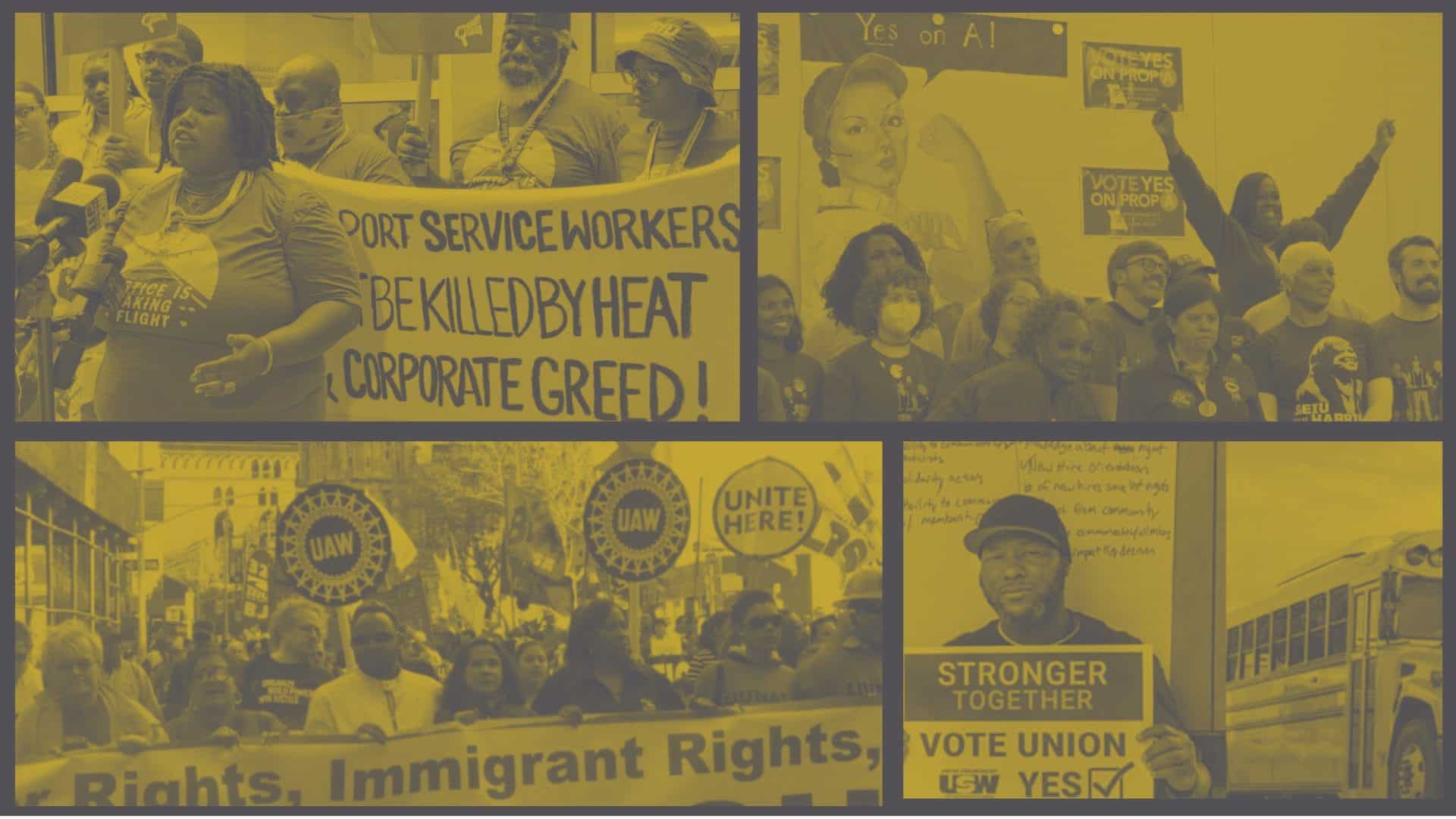With each passing day, we’re seeing more signs of our federal government becoming on oligarchy that puts the economic interests of the ultra-rich above the needs of ordinary Americans. In the face of this billionaire takeover in Washington, state governments need to step up and fight for the working class. Here are eight ways states can combat inequality and support economic justice.
1. Lock in new federal labor protections
President Trump’s administration and right-wing judges are expected to repeal or block many of President Biden’s new labor protections, including safeguards against working in extreme heat, broader overtime pay coverage, and new organizing rights.
The National Employment Law Project, the Economic Policy Institute, and several other pro-worker organizations have put together a guide for state policymakers who want to preserve these important policies.
The report cites numerous existing models. For instance, four states have already expanded overtime protections, six have enacted heat protections, and several have banned or curbed the use of non-compete agreements that suppress wages and trap workers in abusive situations.

2. Build worker power with public funding
Republicans are attempting to seize funds Congress has already authorized for public infrastructure and clean energy projects across the country. We must fight these attacks while also continuing to pressure state and local officials to make sure public funds create good jobs and build worker power.
A new Demos report provides detailed recommendations for state lawmakers seeking to do just that. The report includes three case study examples:
– Requirements covering Maryland offshore wind energy contractors to negotiate project labor agreements with their employees
– A union neutrality agreement with Blue Bird, a company using federal EPA funds to build electric school buses in Georgia
– A community benefits agreement setting job creation and racial and gender equity targets related to contracts with New Flyer bus manufacturing facilities in Alabama and California
During the Biden administration, a labor-community alliance known as the Local Opportunities Coalition succeeded in securing changes to federal procurement rules to make it easier for state and local governments to attach pro-worker conditions on federally funded projects, including requirements to prioritize local workers in hiring. The city council in Birmingham, Alabama recently voted unanimously to adopt such standards for federally funded local infrastructure projects.

3. Raises taxes on the rich to pay for human needs
Trump and the Republican-controlled Congress are preparing to ram through a tax agenda that will overwhelmingly benefit the ultra-wealthy. Fortunately, states and cities have significant power to advance fair tax reform — and such actions are enormously popular.
In 2022, Massachusetts voters overwhelmingly passed a tax hike on high earners, a reform that is now generating significant new public revenue for tuition-free community college. The cities of San Francisco and Portland, Oregon are raising revenue for public services through tax increases on companies with large gaps between CEO and worker pay.
READ: Remember These Greedy Low-Wage Corporations That Prioritize Inflated CEO Pay Over Workers
This past November, voters in Washington state protected that state’s path-breaking capital gains tax on the rich from a ballot measure repeal effort. In Illinois, voters adopted a nonbinding measure expressing support for an extra 3 percent tax on income of over $1 million.
Building on this momentum, Maryland Governor Wes Moore recently floated a plan to lower income taxes on most state residents while raising them on those making more than $500,000 per year (a tier that represents roughly the top 20 percent of earners). Moore also wants to impose a 1 percent surcharge on capital gains income for households that earn more than $350,000.
Shortly before leaving office, Washington Governor Jay Inslee proposed a new 1 percent wealth tax on state residents’ total assets over $100 million. Advocates are pressing new Governor Bob Ferguson, also a Democrat, to support the plan.

4. Stand up to Trump’s war on immigrants
By scapegoating immigrants, Trump aims to sow divisions among ordinary people and divert attention from his plans to slash public services to pay for tax giveaways for the rich.
A wide array of immigrant justice groups, including United We Dream and Detention Watch, are working 24/7 to defend immigrant communities from raids, detention, and deportation. The AFL-CIO has put together a toolkit for protecting immigrant workers, and they and other unions are organizing trainings for grassroots labor and other activists.
What can state and local governments do? Over the years, many states, counties, and cities across the country have adopted “sanctuary” policies. While the details vary, these policies generally limit cooperation of local law enforcement with federal ICE agents seeking to deport undocumented immigrants, with exceptions for violent criminals.
READ: Central Bucks Community Grapples with the Specter of ICE Raids at Local Schools
The Trump Justice Department is threatening to withhold federal funds from sanctuary states and cities that refuse to comply with new anti-immigrant mandates. But they tried something similar during Trump’s first term and California successfully sued to block the action.
In the meantime, rights groups are continuing to press state officials to resist this onslaught.
Maryland-based CASA, for instance, is pushing a bundle of bills in that state’s legislature, including proposals to prevent federal agencies from exploiting Maryland’s data to target residents and stopping the state’s voluntary and unfunded partnerships with ICE. They also want new limits on ICE agents’ access to schools, churches, hospitals, and courthouses so these can remain safe havens for Marylanders to seek education, healthcare, and justice without fear.
5. Pass state minimum wage hikes and paid leave policies
Nearly all GOP politicians are opposed to raising the federal minimum wage, even though it’s been stuck at just $7.25 per hour since 2009. Trump’s billionaire Treasury Secretary Scott Bessent confirmed his opposition during his recent confirmation hearing.
Given the impasse in Washington, many states – including several deep red ones – have raised their own wage floors in recent years. Last November, voters in the heavily Republican states of Missouri and Alaska raised their state minimum wages, and (along with Nebraska) they also approved guaranteed paid leave.
Some 20 states still use the pathetically low federal minimum of $7.25. But one of them — Oklahoma — will have a wage hike on the ballot in the 2026 mid-term election, and given the popularity of these pro-worker reforms, advocates are likely to push them onto ballots and into legislatures in several more states.

6. Build public sector union power
Trump, Elon Musk, and other pro-austerity forces are on a rampage against federal government workers. Their goals? To undercut confidence in public institutions and reduce the power of this largely unionized workforce.
Public sector unions at the state and local levels also face steep challenges, particularly since the U.S. Supreme Court ruled in the 2018 Janus v. AFSCME case that these unions cannot require workers who are not union members to pay dues — even if the workers benefit from collective bargaining agreements. Much like many states’ “right-to-work” laws affecting private sector unions, these restrictions undercut union power and worker wages.
The Center for American Progress has just released a set of recommendations for state lawmakers on how they can build public sector union power in spite of the Janus restrictions. For example, state officials can extend bargaining rights to all public sector workers — including home care and child care workers as well as state and local college and university employees. Lawmakers can also extend the right to strike to all public sector workers — and make sure striking workers can access unemployment and health insurance benefits.
7. Protect public pensions’ authority to support workers
Rightwing forces are also attacking another source of public sector workers’ power: their pension funds. Strategic investment of these large pools of workers’ capital can support good jobs and advance equity and sustainability. But these funds face multiple threats, including attacks on their ability to take social and environmental factors into account when making investment decisions.
READ: Philly Whole Foods Store Becomes First to Unionize. What’s Next?
As Natalia Renta of Americans for Financial Reform points out in a new report, these attacks are part of a broader corporate-driven campaign to slow the clean energy transition, curtail labor power, and reverse progress on racial and gender justice.
Fortunately, state governments have many tools to protect state and local pensions from federal attacks and, in Renta’s words, “wrestle power over workers’ money away from Wall Street and corporate interests and towards workers, their families, and communities.” Her new report offers a detailed roadmap for state legislative and regulatory actions to expand pension funds’ abilities to make investment decisions in public employees’ best interests.
8. Break up monopoly power
The Biden administration, under the leadership of Federal Trade Commission head Lina Khan, enforced anti-trust laws much more aggressively than we’ve seen in recent decades. It’s highly unlikely the Trump regime will keep up this tough federal enforcement to protect consumers and workers from excessive corporate power.
In the meantime, the American Economic Liberties Project is educating state-level officials about what they can do on the anti-monopoly front. One of their new reports outlines 11 policy actions to curb the monopoly power of public utilities. They include recommendations to stop utilities from using ratepayer money for political lobbying activities. They also call for a ban on abusive fees and the promotion of independent power distribution and public power options. A second resource lays out how states can prevent investor-owned utilities from overcharging the public just to enrich their shareholders.
This article was originally published at Inequality.org, a project of the Institute for Policy Studies. It is reprinted here via Creative Commons 3.0.






